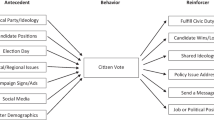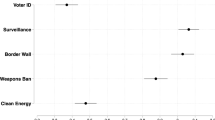Abstract
This research considers whether there is evidence of legislators' issue avoidance, or unwillingness to reveal one's position. It links, for the first time, two important areas of inquiry: legislative decision making and issue avoidance. The data describe senatorial behavior over eighteen years, involving approximately 200,000 individual voting decisions. During that time, senators were polled by CQ after each missed roll call, and asked to indicate their positions. Issue avoidance is a subset of the nonresponses to that poll. A conceptual model of voting and position taking is presented, incorporating both behaviors and intentions. It defines two kinds of issue avoidance: “proactive,” deliberate avoidance at the time of the roll call, and “reactive,” avoidance decided on after votes missed inadvertently. Application of the model permits inferences about intent. Proactive avoidance accounts for 12% of nonvoting during the terms' first five years. It also represents 40% of failures to reveal positions. As much as another 19% of nonvoting results in reactive avoidance. A sixth-year increase in issue avoidance is indicated, although not conclusively. The findings strongly suggest that models of legislative voting should be amended to account for both proactive and reactive avoidance.
Similar content being viewed by others
References
Abramowitz, Alan I. (1988). Explaining senate election outcomes.American Political Science Review 82(2): 385–403.
Amacher, Ryan, and William Boyes (1978). Cycles in senatorial voting behavior: Implications for the optimal frequency of elections.Public Choice 33(3): 5–13.
Bartels, Larry M. (1986). Issue-voting under uncertainty: An empirical test.American Journal of Political Science 30(4).
Bernstein, Robert A., Gerald C. Wright, Jr., and Michael Berkman (1988). Do U.S. senators moderate strategically?American Political Science Review 82(1): 237–245.
Campbell, James E. (1983). Ambiguity in the issue-positions of presidential candidates: A causal analysis.American Journal of Political Science 27(2): 284–293.
Carmines, Edward G., and J. David Gapoian (1981). Issue coalitions, issueless campaigns: The paradox of rationality in American presidential elections.Journal of Politics 43(4): 1170–1189.
Cavanagh, Thomas E. (1979). Rational allocation of Congressional resources: Member time and staff use in the House. In Douglas W. Rae and Theodore J. Eisenmeier (eds.),Public Policy and Public Choice. Beverly Hills, CA: Sage.
Clausen, A. R. (1973).How Congressmen Decide. New York: St. Martin's.
Congressional Quarterly Almanac. Washington, DC: Congressional Quarterly, (Note: CQ Almanacs from 1959 to 1976 with publication dates of 1960 to 1977 respectively.)
Congressional Quarterly Weekly Report (Dec. 29, 1967). Twenty-three percent of members miss Monday, Friday roll-call votes.
Elling, Richard C. (1982). Ideological change in the United States senate: Time and electoral responsiveness.Legislative Studies Quarterly 7(1): 75–92.
Fenno, Richard F. (1978).Home Style. Boston, MA: Little, Brown.
Fiorina, Morris P. (1974).Representatives, Roll-Calls and Constituencies. Lexington, MA: Heath.
Garvey, Gerald (1966). The theory of party equilibrium.American Political Science Review 60(1): 29–38.
Guide to U.S. Elections (1975). Washington, DC: Congressional Quarterly.
Hinich, Melvin, and Peter Ordeshook (1969). Abstentions and equilibrium in the electoral process.Public Choice 7(Fall): 81–106.
Key, V. O., Jr. (1958).Politics, Parties and Pressure Groups, 4th ed. New York: Crowell.
Kingdon, John W. (1973).Congressman's Voting Decisions. New York: Harper and Row.
Kramer, Gerald H. (1966). A decision-theoretic analysis of a problem in campaigning. In Joseph L. Bernd (ed.),Mathematical Applications in Political Science, II. Dallas, TX: SMU Press.
Kuklinski, James H. (1978). Representatives and elections: A policy analysis,American Political Science Review 72: 165–177.
Lau, Richard R. (1985). Two explanations for negativity effects in political behavior.American Journal of Political Science 29(1): 119–138.
Matthews, Donald R., and James A. Stimson (1975).Yeas and Nays: Normal Decision-making in the U.S. House of Representatives. New York: Wiley.
Mayhew, David R. (1974).Congress: The Electoral Connection. New Haven, CT: Yale University Press.
Page, Benjamin I. (1976). The theory of political ambiguity.American Political Science Review 70: 742–752.
Page, Benjamin, I., and Richard Brody (1972). Policy voting and the electoral process: The Vietnam War issue.American Political Science Review 66(3): 979–995.
Scammon, Richard M., and Alice V. McGillivray (1977).America Votes 12: A Handbook of Contemporary American Election Statistics. Washington, DC: Congressional Quarterly.
Shepsle, Kenneth A. (1972). The strategy of ambiguity: Uncertainty and electoral competition.American Political Science Review 66(2): 555–568.
Thomas, Martin (1985). Election proximity and senatorial roll-call voting.American Journal of Political Science 29(1): 96–111.
Weaver, R. Kent (1987). The politics of blame avoidance.Journal of Public Policy 6(4): 371–398.
Webber, David J. (1987). The contours and complexity of legislator objectives: Empirically examining the basis of purposive models.Western Political Quarterly 39(1).
Whitby, Kenny J., and Timothy Bledsoe (1987). The impact of policy voting on the electoral fortunes of senate incumbents.Western Political Quarterly 39(4): 690–700.
Wright, Gerald C., Jr., and Michael B. Berkman (1986). Candidates and policy in U.S. Senate elections.American Political Science Review 80: 568–590.
Author information
Authors and Affiliations
Rights and permissions
About this article
Cite this article
Thomas, M. Issue avoidance: Evidence from the U.S. senate. Polit Behav 13, 1–20 (1991). https://doi.org/10.1007/BF00996996
Issue Date:
DOI: https://doi.org/10.1007/BF00996996




